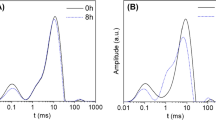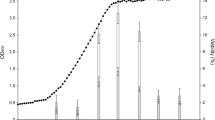Abstract
Leavening ability in sweet dough is required for the commercial applications of baker’s yeast. This property depends on many factors, such as glycolytic activity, sucrase activity, and osmotolerance. This study explored the importance of sucrase level on the leavening ability of baker’s yeast in sweet dough. Furthermore, the baker’s yeast strains with varying sucrase activities were constructed by deleting SUC2, which encodes sucrase or replacing the SUC2 promoter with the VPS8/TEF1 promoter. The results verify that the sucrase activity negatively affects the leavening ability of baker’s yeast strains under high-sucrose conditions. Based on a certain level of osmotolerance, sucrase level plays a significant role in the fermentation performance of baker’s yeast, and appropriate sucrase activity is an important determinant for the leavening property of baker’s yeast in sweet dough. Therefore, modification on sucrase activity is an effective method for improving the leavening properties of baker’s yeast in sweet dough. This finding provides guidance for the breeding of industrial baker’s yeast strains for sweet dough leavening. The transformants BS1 with deleted SUC2 genetic background provided decreased sucrase activity (a decrease of 39.3 %) and exhibited enhanced leavening property (an increase of 12.4 %). Such a strain could be useful for industrial applications.



Similar content being viewed by others
References
Agblevor FA, Hames BR, Schell D, Chum HL (2007) Analysis of biomass sugars using a novel HPLC method. Appl Biochem Biotechnol 136:309–326
Angel Yeast Corporation (2007) Yeast used for food processing. Chinese National Standard GB/T 20886–2007
Attfield PV (1997) Stress tolerance: the key to effective strains of industrial baker’s yeast. Nat Biotechnol 15:1351–1357
Badotti F, Dário MG, Alves SL Jr, Cordioli ML, Miletti LC, de Araujo PS, Stambuk BU (2008) Switching the mode of sucrose utilization by Saccharomyces cerevisiae. Microb Cell Factories 7:4. doi:10.1186/1475-2859-7-4
Bell PJ, Higgins VJ, Attfield PV (2001) Comparison of fermentative capacities of industrial baking and wild-type yeasts of the species Saccharomyces cerevisiae in different sugar media. Lett Appl Microbiol 32:224–229
Bethke PC, Busse JC (2008) Validation of a simple, colorimetric, microplate assay using amplex red for the determination of glucose and sucrose in potato tubers and other vegetables. Am J Pot Res 85:414–421
Carlson M, Osmond BC, Botstein D (1981) Mutants of yeast defective in sucrose utilization. Genetics 98:25–40
Carlson M, Celenza JL, Eng FJ (1985) Evolution of the dispersed SUC gene family of Saccharomyces by rearrangements of chromosome telomeres. Mol Cell Biol 5:2894–2902
Evans IH (1990) Yeast strains for baking: recent developments. In: Spencer JFT, Spencer DM (eds) Yeast technology. Springer, Germany, pp. 13–54
Gietz RD, Woods RA (2002) Transformation of yeast by lithium acetate/single-stranded carrier DNA/polyethylene glycol method. Methods Enzymol 350:87–96
Güldener U, Heck S, Fielder T, Beinhauer J, Hegemann JH (1996) A new efficient gene disruption cassette for repeated use in budding yeast. Nucleic Acids Res 24:2519–2524
Güldener U, Heinisch J, Köehler GJ, Voss D, Hegemann JH (2002) A second set of loxP marker cassettes for Cre-mediated multiple gene knockouts in budding yeast. Nucleic Acids Res 30:e23
Hernandez-Lopez MJ, Prieto JA, Randez-Gil F (2003) Osmotolerance and leavening ability in sweet and frozen sweet dough. Comparative Analysis between Torulaspora delbrueckii and Saccharomyces cerevisiae baker’s yeast strains. Antonie Van Leeuwenhoek 84:125–134
Hohmann S, Zimmermann FK (1986) Cloning and expression on a multicopy vector of five invertase genes of Saccharomyces cerevisiae. Curr Genet 11:217–225
Jiang TX, **ao DG, Gao Q (2008) Characterisation of maltose metabolism in lean dough by lagging and non-lagging baker’s yeast strains. Ann Microbiol 58:655–660
Korshunova IV, Naumova ES, Naumov GI (2005) Comparative molecular-genetic analysis of the beta-fructosidases in yeast Saccharomyces. Mol Biol 39:413–419
Lin X, Zhang CY, Bai XW, Song HY, **ao DG (2014) Effects of MIG1, TUP1 and SSN6 deletion on maltose metabolism and leavening ability of baker’s yeast in lean dough. Microb Cell Factories 13:93. doi:10.1186/s12934-014-0093-4
Lin X, Zhang CY, Bai XW, **ao DG (2015) Enhanced leavening ability of baker’s yeast by overexpression of SNR84 with PGM2 deletion. J Ind Microbiol Biotechnol 42:939–948. doi:10.1007/s10295-015-1618-5
Lu J, Dong J, Wu D, Chen Y, Guo X, Shi Y, Sun X, **ao D (2012) Construction of recombinant industrial brewer’s yeast with lower diacetyl production and proteinase A activity. Eur Food Res Technol 235:951–961
Miller GL (1959) Use of dinitrosalicylic acid reagent for determination of reducing sugar. Anal Chem 31:426–428
Myers DK, Lawlor DT, Attfield PV (1997) Influence of invertase activity and glycerol synthesis and retention on fermentation of media with a high sugar concentration by Saccharomyces cerevisiae. Appl Environ Microbiol 63:145–150
Naumov GI, Naumova ES, Sancho ED, Korhola MP (1996) Polymeric SUC genes in natural populations of Saccharomyces cerevisiae. FEMS Microbiol Lett 135:31–35
Nevoigt E, Kohnke J, Fischer CR, Alper H, Stahl U, Stephanopoulos G (2006) Engineering of promoter replacement cassettes for fine-tuning of gene expression in Saccharomyces cerevisiae. Appl Environ Microbiol 72:5266–5273
Oda Y, Ouchi K (1990) Effect of invertase activity on the leavening ability of yeast in sweet dough. Food Microbiol 7:241–248
Randez-Gil F, Sanz P, Prieto JA (1999) Engineering baker’s yeast: room for improvement. Trends Biotechnol 17:237–244
Randez-Gil F, Córcoles-Sáez I, Prieto JA (2013) Genetic and phenotypic characteristics of baker’s yeast: relevance to baking. Annu Rev Food Sci Technol 4:191–214. doi:10.1146/annurev-food-030212-182609
Sasano Y, Haitani Y, Hashida K, Ohtsu I, Shima J, Takagi H (2012a) Enhancement of the proline and nitric oxide synthetic pathway improves fermentation ability under multiple baking-associated stress conditions in industrial baker’s yeast. Microb Cell Factories 11:40. doi:10.1186/1475-2859-11-40
Sasano Y, Haitani Y, Ohtsu I, Shima J, Takagi H (2012b) Proline accumulation in baker’s yeast enhances high-sucrose stress tolerance and fermentation ability in sweet dough. Int J Food Microbiol 152:40–43. doi:10.1016/j.ijfoodmicro.2011.10.004
Sasano Y, Haitani Y, Hashida K, Oshiro S, Shima J, Takagi H (2013) Improvement of fermentation ability under baking-associated stress conditions by altering the POG1 gene expression in baker’s yeast. Int J Food Microbiol 165:241–245. doi:10.1016/j.ijfoodmicro.05.015
Shima J, Takagi H (2009) Stress-tolerance of baker’s-yeast (Saccharomyces cerevisiae) cells: stress-protective molecules and genes involved in stress tolerance. Biotechnol Appl Biochem 53:155–164. doi:10.1042/BA20090029
Takagi H (2008) Proline as a stress protectant in yeast: physiological functions, metabolic regulations, and biotechnological applications. Appl Microbiol Biotechnol 81:211–213. doi:10.1007/s00253-008-1698-5
Tokashiki T, Yamamoto H, Watanabe H, Nakajima R, Shima J (2011) A functional compound contained in sugar cane molasses enhances the fermentation ability of baker’s yeast in high-sugar dough. J Gen Appl Microbiol 57:303–307
Verstrepen KJ, Thevelein JM (2004) Controlled expression of homologous genes by genomic promoter replacement in the yeast Saccharomyces cerevisiae. Methods Mol Biol 267:259–266
Verstrepen KJ, Iserentant D, Malcorps P, Derdelinckx G, Van Dijck P, Winderickx J, Pretorius IS, Thevelein JM, Delvaux FR (2004) Glucose and sucrose: hazardous fast-food for industrial yeast? Trends Biotechnol 22:531–537
Vitolo M, Borzani W (1983) Measurement of invertase activity of cells of Saccharomyces cerevisiae. Anal Biochem 130:469–470
Acknowledgments
The current study was financially supported by the National Natural Science Foundation of China (31571809) and the National High Technology Research and Development Program of China (2013AA102106).
Author information
Authors and Affiliations
Corresponding authors
Ethics declarations
Ethical statement
This manuscript is in compliance with ethical standards. This manuscript does not contain any studies with human participants or animals performed by any of the authors.
Conflict of interest
The authors declare that they have no competing interests.
Additional information
Cui-Ying Zhang and Xue Lin are the co-first authors in this study.
Electronic Supplementary Material
ESM 1
(PDF 301 kb)
Rights and permissions
About this article
Cite this article
Zhang, CY., Lin, X., Feng, B. et al. Enhanced leavening properties of baker’s yeast by reducing sucrase activity in sweet dough. Appl Microbiol Biotechnol 100, 6375–6383 (2016). https://doi.org/10.1007/s00253-016-7449-0
Received:
Revised:
Accepted:
Published:
Issue Date:
DOI: https://doi.org/10.1007/s00253-016-7449-0




